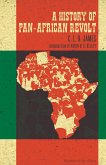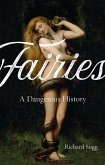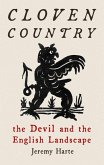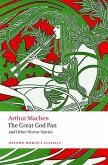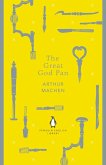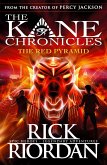14,99 €
inkl. MwSt.
Versandfertig in über 4 Wochen

7 °P sammeln
- Broschiertes Buch
- Merkliste
- Auf die Merkliste
- Bewerten Bewerten
- Teilen
- Produkt teilen
- Produkterinnerung
- Produkterinnerung
A beautifully written celebration of the god of music, lust and wine, Pan.
Andere Kunden interessierten sich auch für
![A History Of Pan-african Revolt A History Of Pan-african Revolt]() CLR JamesA History Of Pan-african Revolt17,99 €
CLR JamesA History Of Pan-african Revolt17,99 €![Fairies Fairies]() Richard SuggFairies16,99 €
Richard SuggFairies16,99 €![Cloven Country Cloven Country]() Jeremy HarteCloven Country21,99 €
Jeremy HarteCloven Country21,99 €![Cloven Country Cloven Country]() Jeremy HarteCloven Country12,99 €
Jeremy HarteCloven Country12,99 €![The Great God Pan and Other Horror Stories The Great God Pan and Other Horror Stories]() Arthur MachenThe Great God Pan and Other Horror Stories12,45 €
Arthur MachenThe Great God Pan and Other Horror Stories12,45 €![The Great God Pan The Great God Pan]() Arthur MachenThe Great God Pan7,99 €
Arthur MachenThe Great God Pan7,99 €![The Kane Chronicles 01. The Red Pyramid The Kane Chronicles 01. The Red Pyramid]() Rick RiordanThe Kane Chronicles 01. The Red Pyramid6,99 €
Rick RiordanThe Kane Chronicles 01. The Red Pyramid6,99 €-
-
-
Produktdetails
- Produktdetails
- Verlag: Reaktion Books
- Seitenzahl: 344
- Erscheinungstermin: 1. Februar 2023
- Englisch
- Abmessung: 223mm x 142mm x 27mm
- Gewicht: 452g
- ISBN-13: 9781789146905
- ISBN-10: 1789146909
- Artikelnr.: 66154271
- Verlag: Reaktion Books
- Seitenzahl: 344
- Erscheinungstermin: 1. Februar 2023
- Englisch
- Abmessung: 223mm x 142mm x 27mm
- Gewicht: 452g
- ISBN-13: 9781789146905
- ISBN-10: 1789146909
- Artikelnr.: 66154271
A native of Toronto, Paul Robichaud is professor and chair of English at Albertus Magnus College in New Haven, Connecticut. He is the author of David Jones, the Middle Ages, and Modernism, and his poems have appeared in various magazines, including Agenda and the Hudson Review. The Greek god Pan emerges into the knowable past as a guardian of flocks and inducer of panic terror, combining the physical features of goat and man. Yet from these remote origins he comes to have a rich variety of identities that shift and change through the centuries: cosmic god of All; symbol of bestial lust; demon; protector of forests; cipher for Stuart monarchs; symbol of the latent powers in nature; terrifying god of the abyss; source of occult knowledge; symbol of gay love; guardian of wild animals; Horned God of the witches; ruler of nature spirits; archetype of the unconscious; and many more. If these irreconcilable interpretations of the god have anything in common, it is that they register a powerful sense of otherness in the face of the radically different or unknown. Whether divine or demonic, animal or royal, this recognition of profound difference suddenly transfiguring the ordinary persists in representations of Pan into the twenty-first century. This book explores the ways in which the Great God Pan has been imagined from antiquity to the present. Surveying Pan's role in mythology, art, literature, music, spirituality and popular culture, it shows how portrayals of the god reveal shifting anxiety about our own animality and our relationship to the natural world, whether this is understood as the wilderness beyond civilization or the cosmos as a whole. Pan is a god who transgresses the boundaries between human and animal, refusing to abandon the wilderness for civilization. After lurking in the shadows during the later Renaissance and eighteenth century, Pan returns in the Romantic era as a potent symbol of our instinctual life and the otherness of natural forces that live through us. At times he is a dangerous power threatening the order of modern civilization; at others, he is a power of fertility and renewal offering a new hope for our relationship with nature. In surveying the god's changing identity in Western culture, I have chosen to focus on those works and individuals that re-imagine Pan in original ways, or are recognized as important in their own right. Others clearly articulate or explore aspects of the Pan tradition in ways that influence its later development. Occasionally I have included material simply because I thought it would interest any reader as fascinated by Pan as I am. In exploring Pan's role in occult and New Age spirituality, I have taken the accounts of believers seriously and do not attempt to explain them away. They strike me as valid examples of what the psychologist and philosopher William James called 'the varieties of religious experience'. How such experiences are understood, however, is shaped by a long tradition of cultural representation that culminates in the late nineteenth and early twentieth centuries. For Pagan readers who may believe in Pan (in one form or another), this book follows the historian Ronald Hutton's lead in leaving open the question of the existence of the gods. What are treated as changing representations of Pan in this book could, from a Pagan perspective, also be read as a gradual process of discovery - perhaps even of revelation. In her magisterial study Pan the Goat-God: His Myth in Modern Times (1969), Patricia Merivale distinguished between 'benevolent' and 'sinister' traditions of representing the god. This is a valid contrast, particularly when considering the nineteenth- and twentieth-century literature that is her focus. Taking a somewhat more inclusive view, however, I have found the ancient distinction between Pan's pastoral and cosmic aspects more helpful, a distinction that I explore in the first chapter. As we'll see, both pastoral and cosmic aspects of Pan's character have been imagined in 'benevolent' and 'sinister' ways. A horror writer such as Arthur Machen depicts Pan as the terrifying power of the Abyss, while a visionary such as Robert Ogilvie Crombie sees a benign cosmic power nurturing life on Earth. How we experience Pan may depend much on our own assumptions and predispositions. A very few artists, D. H. Lawrence foremost among them, have attempted to convey Pan holistically, but even Lawrence rejected his more goatish associations. It is the tradition of depth psychology, and its focus on the unconscious, that has come closest to making sense of Pan in all his wild contradictions. This book is written for readers interested in learning more about the goat-footed God and how he has been imagined through the centuries. While Merivale was writing for an audience of fellow scholars, I have not assumed that the reader has prior knowledge of the material explored here. My approach to individual texts, works of art and musical compositions is to introduce them and consider how they imagine Pan, relating them where possible to the larger tradition of which they form a part. Should the reader wish to follow up and read works in their entirety, I have referred where possible to readily accessible online editions. I am not a classicist, and in writing about the ancient world I have relied on the work of translators and scholars, especially Philippe Borgeaud, whose The Cult of Pan in Ancient Greece (1988) remains the major study of how Pan was conceived and worshipped in antiquity. In selecting visual works of art depicting Pan, I have been guided by John Boardman's The Great God Pan: The Survival of an Image (1998), a short but excellent survey.

